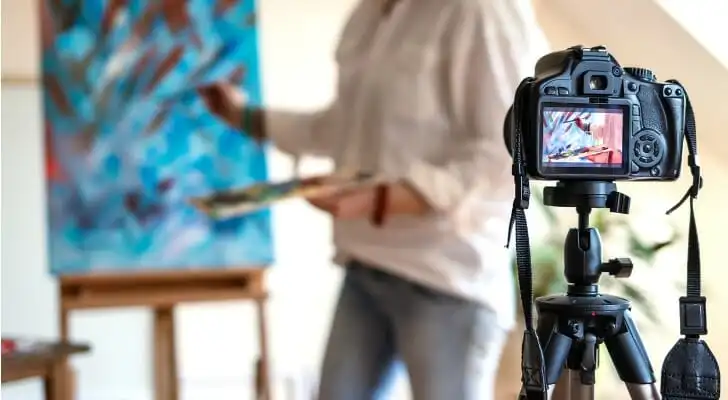 Most people are familiar with traditional investment options like stocks, bonds and real estate. Some investors may be looking for ways to diversify their portfolio, though. One way to do that is by putting money into what is sometimes called alternative investments. One type of alternative investment is known as collectibles and includes such items as antique musical instruments, jewelry and first edition classics. One common type of collectible is artwork. These items sometimes appreciate in value, but are they right for your portfolio? Here’s what you need to know.
Most people are familiar with traditional investment options like stocks, bonds and real estate. Some investors may be looking for ways to diversify their portfolio, though. One way to do that is by putting money into what is sometimes called alternative investments. One type of alternative investment is known as collectibles and includes such items as antique musical instruments, jewelry and first edition classics. One common type of collectible is artwork. These items sometimes appreciate in value, but are they right for your portfolio? Here’s what you need to know.
Consider working with a financial advisor on suitable alternative investments for your portfolio.
Art can act like any other investment where it gains value over time. It’s also made of more than the household names you may know. Many art investors collect works from newer or up-and-coming artists, hoping that the piece’s value will increase. Although it experienced a recent drop in 2020 due to COVID-19, the global art market amounted to more than $50 billion in 2020 and more than $64 billion in 2019, according to Statista.
How to Invest in Art
Investing in art comes with its own range of risks. If you don’t have a strategy in place, you risk losing a significant amount of money over fakes, copies or low-value duds. So, it’s important to take the time. Here are some tips as you explore investing in artworks:
- Establish a realistic budget – According to Artnet, 2020 may have seen a drop in fine art auction sales, but demand for lower-priced pieces remained consistent. “Auction houses are … meeting buyers where they are,” the site reported in April 2020. That shows that a smaller budget is still valuable. So, you don’t have to come up with a large spending range. Find the minimum and maximum you are willing to spend and only buy within that bracket of your budget.
- Do your research – Investing in art is not an area where you’ll benefit from going in “blind.” Take the appropriate amount of time before you shop or head into an auction to research. There is plenty of information at your fingertips through the internet, whether it be videos, journals, databases or blogs. You can also visit local museums, galleries or pop-up art exhibitions in your spare time. Overall, you should find the type of artwork that interests you and fits into your financial goals. That requires you to build up your knowledge about various art movements, styles, mediums and more.
- Avoid trends – If you never put thought into art before, it might seem like it’s all the same. However, the world of art is made up of more styles and directions than you probably realized. So, while some may prefer a certain school of art, you might not. Don’t follow buying trends without taking into account your preferences. There may be other investing patterns that suit you better.
- Comparison shop – When you like a certain musician, you look for others with a similar sound. The same sort of method applies when you investigate which artists work for you. If one piece stands out, look into the artist’s other works. If that painter, sculptor, etc., was a part of a movement, look for others that match. It’s easy to get an idea of an art piece thanks to the internet. However, try to see a work in person or obtain the dimensions before you make the purchase.
- Instinct is essential – Your preparation and research can fly out the window if you fall under pressure. Gallerists and art advisors may try to sway you towards certain moves. Or, the opinions of others might simply make you doubt yourself. Stick to your initial reaction, though. Ask for details about the piece you’re most interested in and take your time with it.
What to Look for When Buying Art Investments
Once again, if you’re not familiar with the art world beforehand, it can be overwhelming. There are numerous combinations of styles and mediums. So, narrow your search down as much as possible. Find the era or direction which interests you most. Some types of art you may run into include:
- Originals – Like the name suggests, it’s the original piece. Their rarity determines their high prices, but they usually have the biggest resell value.
- Prints – These are copies of originals. They are still considered art and retain value, but at a much more affordable price. That also lowers their payoff, though. Their rarity (and thus value) increases depending on the techniques involved, whether it’s from a limited batch or if the artists signed it. Prints are good starting points for some collectors; however, it’s important to know whether a print will increase in value or not.
- Gicleés – This a higher quality print. They are priced higher than normal prints as a result and are often classified as “museum quality.” When you purchase one from a dealer, it will likely come with a certificate of authenticity.
- Reproduction – These are also copies of an original work. However, unlike prints, they’re not made on a limited run. They’re the most affordable option but don’t have much investment value.
It’s also recommendable, especially if you’re a beginner, to work with an art advisor or investment professional specializing in art. While you can take the time to research, art investment involves a lot of know-how, and having someone with the right knowledge is valuable. Not only can they help with identification, but they can help you determine the appropriate price for a work.
Understanding Risks Involved in Art Investments
Just like any other type of investment, art comes with its financial risks. One of the main risks is an inability to sell the item in a timely fashion. In other words, art tends to be highly illiquid. Another risk is that the art may depreciate in value rather than appreciate. For example, there’s no guarantee any artist will remain popular or create works with a consistent value. Even some of the most famous artists weren’t appreciated during their time.
So, you may take an interest in an upstart artist. You like the person’s work, and it seems like people are starting to notice the talent. However, within the next year, someone has taken that artist’s place. Overall, it’s hard to predict who will stay a permanent fixture in the community and who will fade out.
Sometimes you can mitigate that risk when you have a solid art history or appraisal foundation. But there are multiple markets, and a lower-priced item in one doesn’t automatically make it a steal. Depending on which market you’re investing in, you’ll see works subject to different price scaling. It’s important to know what the comparative value is within the medium or era, whether you are looking at etchings, prints, photographs, paintings, etc.
There are also associated costs with keeping a work safe. You may think you can buy an oil painting and then hang it up in your home. But artworks often require a particular climate to keep them from getting damaged. That may be even more important if you wait long-term for the value to increase. So, you have to work out a place to store the piece, which can be a significant price. Furthermore, if you have to ship it anywhere, insure it. And when it arrives, insure it again.
Overall, it’s vital to have the right knowledge going in. Otherwise, you may spend more than you mean to without any solid return waiting at the end.
Is Art a Good Investment?
Art is a long-term investment. Numerous art investors even include art in their estate plan. This means that there is the possibility of a high return after the work has accrued value. Also, the art market doesn’t follow the same patterns as the stock market. Therefore, even if your ETFs or stocks perform poorly, your art investment’s value could remain high or even increase. Part of that value depends on the rarity of the work, though, and with that comes risk. Many factors can shift the value of the work in your possession. Some investors may not be comfortable with that kind of risk, whereas others may see it as an opportunity to diversify their portfolio. Whether it’s a good investment depends on the investor and the circumstances.
Is Art Investing Right for You?
Art investment is in a unique position where you trade in physical items. You can see and enjoy the works you bid on. In fact, many art investors begin their journey as collectors or frequent gallery visitors. So, it’s possible that art investing might be right for you if you love the field enough. It’s better if you do have an affinity for the artworks because they’re typically not profitable. You may find luck every now and then, but keep in mind: the higher the possible return, the more expensive it is to buy. A single piece can sell for millions of dollars.
If you’re not ready to spend that amount and wait long-term to generate a profit when you resell it, you may have to look at smaller artists. However, that means the piece is less valuable.
So, the risk is high, the time horizon is long and it takes consistent research to stay on top of the market. If you can handle that, along with associated maintenance and advisory costs, art investment could work for you.
The Takeaway
Art investments, like investments in other collectibles such as classic cars, vintage clocks and bottles of ultra-high-price wine may not always pay off. Regardless, it’s not the only investment you want in your portfolio. Allocate your assets so that your overall portfolio can accommodate the risks of your art investment. Diversifying minimizes the threat of loss if markets take a turn and protect your financial stability.
Tips for Investors
- Art investment requires you to know your financial standing. Without a solid grasp on your risk tolerance and long-term goals, you risk failure in the future. This is where a financial advisor can be invaluable. Finding one doesn’t have to be hard. Use SmartAsset’s investment calculator to help cement your preferences and objectives. If you’re ready, get started now.
- There are risks when it comes to investing in art, and it’s not alone. Many alternative investment options might not work for your particular situation. However, that shouldn’t stop you from investigating your options. A financial advisor can help you determine which products suit your financial plan and structure a strategy for you to follow. SmartAsset’s free match-up tool makes finding the right financial advisor easy. With only a few questions and five minutes of your time, you’re paired with local advisors ready to help. If you want to go after your financial goals, get started now.
Photo credit: ©iStock.com/SeventyFour, ©iStock.com/Zbynek Pospisil, ©iStock.com/KuznetsovDmitry

